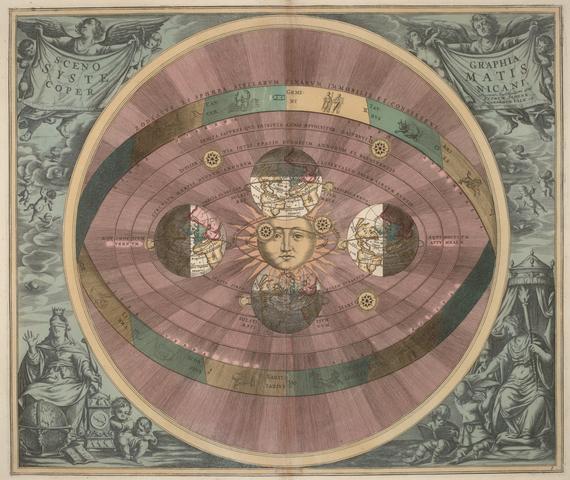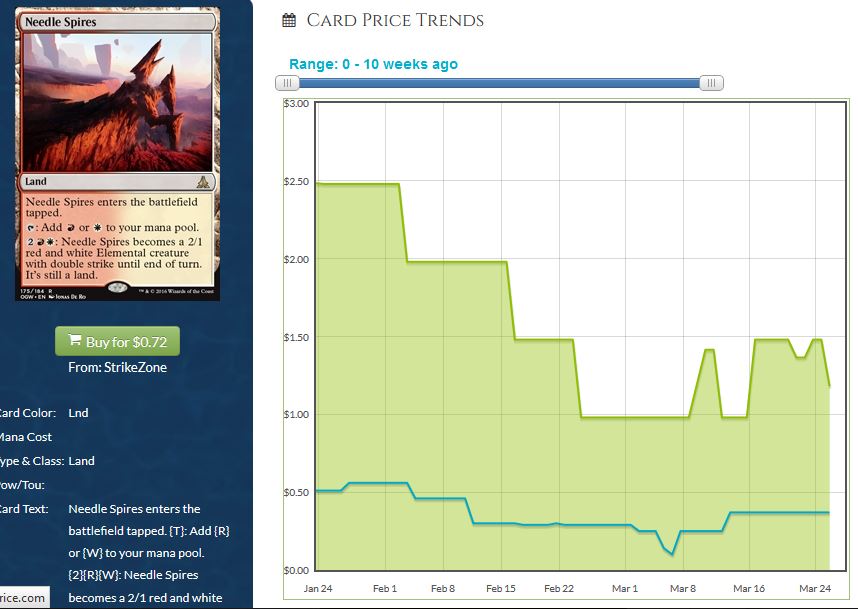I have a feeling many MTG finance eyes will be on three unrelated events: Shadows Over Innistrad’s release, banned and restricted updates for Modern specifically, and the gradual spoiling of Eternal Masters. Each of these separate events will have a very profound impact on card prices, and it’s likely many writers will cover each topic at length. I will most certainly be chiming in with Modern and Legacy impact once we have more information.
As for Standard – I tried to place a few small bets, picking up a handful of creature lands. After seeing the new rare land cycle in Shadows Over Innistrad, however, I fear I placed my money on a slower horse. The Battle Lands have all been rising steadily these last few weeks, and I can only hope the creature lands also find a home in Standard. Until then I’ll remain comforted by the fact that these remain near their bottom and should not drop lower in price.
But there’s one trend that is gradually unfolding, which I think will have a profound impact on the MTG market. Most importantly of all, I believe this trend is occurring so slowly and so out of focus that it’s happening under the radar. People would only notice this trend if they paid extremely close attention to this market, and not many do.
Interested? Here’s the good news – I do pay attention. And this week I’ll share my most recent observations along with some future predictions that can help you make some well-placed and timely investments in MTG.



Don’t forget Pendrell Mists creeping up. 🙂
Hehehe of course! 🙂
Awesome to see this article! The collector aspect of ABU cards is real. Looking at the ratio between them and catching the ones that lag behind once you verify/see the buylists follow is a great opportunity (the caveat – finding a buyer to re-sell to is a much more specialized process and will take time).
It’s interesting how the card values move in fits and spurts sometimes…many cards don’t grow continuously. It seems that there is an interval (every 5 years, every 10 years?) by which the increasing age has enhanced the previous collectability by an order of magnitude and the price must re-evaluate and correct upwards. The time based enhancer can only grow, and is like an ever increasing clock next to the playability or factors that rise and fall.
If you look at old baseball cards there are a group that long outlive even the original game of collecting/playing them and become historically iconic. I think this will be the case with especially iconic cards from the early days of mtg. Not just power, but things like Alpha Northern Paladin, Birds of Paradise, Mind Twist, Chaos Orb, Gauntlet of Might, Forcefield, Fastbond, Icy Manipulator, Berserk… this is not just about playability but art as well. In baseball it was tied to the popularity and later success of the players on the cards. For magic I think it will have to do with art, nostalgia, playability, and especially old broken mechanics! Some will continue to have collectible life long after magic the game is dead, something I don’t foresee anywhere in the near future.
The scarcity of these cards has only grown the last 20 years, and many are now very, very difficult to obtain. Many are also leaving the market for long periods of time as they are hoarded. True NM AB sets? I know people with those that I’m sure will have them until they die. So some cards are leaving the market often for anywhere between 5-20yrs+ in collections.
When speculators, players, and collectors are all vying for an ever dwindling card pool of the lowest printed cards in the history of magic there are real long term opportunities here…. looking at some of these prices feels like looking at a magazine from the 1930s with historic, million dollar classic cars for under 1k. Also consider the player base today, by some estimates around 15mil + and growing. It takes a very small percentage of those people to wax nostalgic (if older players) or get interested in 93/94 or blue-chip mtg speculation to quickly snap up a tiny pool of cards (that especially for many alpha and beta items numbers well under 500 surviving and on the market today). Power is about to take a step up. Seems like a rising tide and all that…
Got a bit rambly there but you got me all amped haha!
yakkus,
Wow, this is an awesome, well-thought out comment. I really appreciate your taking the time to share your thoughts. I also have the same energy you have about these older cards, and it’s a big reason I’ve been shifting the vast majority of my MTG investments to these assets. Not only is it AMAZING to cast a turn 1 Hypnotic Specter again off of Dark Ritual – the long-term values of the original printings of these highly nostalgic cards should only rise.
Considering only 1100 of each Alpha rare was ever printed, these are going to become more and more difficult to find! Think about it – so many Magic rares from Alpha now are down to single digits of stock on the internet. Think 20 years from now – how many Alpha Birds of Paradise will be on the open market? Fastbond? Balance? Sure, there will be a copy or two for sale…but at astronomical prices simply because the supply will be near zero.
I really look forward to seeing these collectible cards grow, and I’m eager to be a part of this community.
Let me know if you want to share ideas some time, as I really enjoy engaging on this subject. 🙂
Thanks again,
Sig
I may be too late to this discussion, but let me suggest that the factor you are missing in your equation is “original playability”. Before tournament Magic existed and even to this day, casuals make up the bulk of the player base. Cards such as Nightmare and Aspect of Wolf that you mention along with cards like Shivan Dragon were hunted for, traded for, and played extensively. Therefore, finding NM copies of many of these cards is just more difficult. Also, take into consideration that nobody used card sleeves at first and then it was only by repurposing the sports card “penny” sleeves. It’s actually a wonder that NM copies exist in any quantity at all, especially for Alpha cards. Overall, you are on the right track, it’s just that there are so many factors involved that you really have to take it on a card by card basis.
I love your term…original playability. Shivan Dragon and Winter Orb are great examples. They always maintained a premium because of this factor. I remember running mono green with aspect of wolf and rabid wombat. 🙂
You bring up a very valid point – original playability has a huge impact on how many Near Mint copies of older cards exist because no one used sleeves back then. But that only stretches so far – can that factor explain differences between Alpha, Beta and Unlimited? I understand it drives prices higher for Near Mint copies, but I don’t know how it directly translates to Alpha/Beta differentials. What other factors are there?